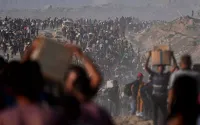Common Dreams / Published on Thursday, August 4, 2005 by the San Francisco Chronicle David R. Baker
Nigerian soldiers guarding Chevron oil rigs billed the company for $109.25 a day after they allegedly attacked two villages in the volatile country, killing four people and setting fire to homes.
The company paid.
The money was requested in a small invoice -- stamped with Chevron's logo and the name of its Nigerian subsidiary -- that surfaced this year as part of a lawsuit against the San Ramon oil giant. Residents of the Opia and Ikenyan villages are suing Chevron in San Francisco's federal court, trying to hold the firm responsible for the fatal attacks in 1999.
In cramped handwriting, the invoice asks for 15,000 naira to pay 23 soldiers who responded to an alleged assault by men from Opia against a Chevron oil rig, called Searrex. Villagers said they had gone to the rig to meet with Chevron representatives and returned home to see soldiers open fire from a hovering helicopter.
To the villagers' lawyers, the invoice shows Chevron knew of the attacks and should be held accountable for them.
"It's an important piece of the story," said Cindy Cohn, legal director of the Electronic Frontier Foundation and one of several attorneys on the case. "Chevron knew what was going on, and Chevron paid the day after."
The company disagrees. Chevron spokesman Charles Stewart said the company is not convinced that the attacks detailed by witnesses in the lawsuit even occurred.
Chevron acknowledges it paid the soldiers but considers it as one of the regular payments it makes to soldiers guarding its facilities in a part of Nigeria known for piracy and ethnic combat. Although the government covers the soldiers' salaries, Chevron pays them an additional sum for taking a "hardship" post, Stewart said.
"They're a per-diem fee that you pay the military for the general protection of the rigs and facilities and assets," he said. "It's not about going to villages and killing people."
Stewart said he didn't know if the company had heard of the attacks on Opia and Ikenyan before paying the men. He also suggested the villages might have come under fire from another ethnic group, if they were attacked at all.
"What we're saying is, to the extent that there were any attacks -- because there's a lot of disagreement on this -- no Chevron Nigeria personnel were present or authorized any such attack," Stewart said.
The invoice's fractured language doesn't mention attacks on the villages. Instead, it requests payment for "services carried out" by an unidentified captain and 22 of his men responding to "attacks from Opia village against security agents guarding Searrex."
The lawsuit is one of several that seek to hold American companies accountable for human rights abuses or environmental damage abroad. Chevron also faces a suit in Ecuador charging that Texaco, before its 2001 acquisition by Chevron, polluted and poisoned a swath of the Amazon rain forest.
In Nigeria, the company relies on government military forces to protect employees and equipment in a country racked by poverty, government corruption and tension among ethnic groups. Villagers who have seen little benefit from the country's immense oil wealth have boarded and staged demonstrations on oil rigs, demanding jobs. Anti-government rebels occasionally threaten to attack oil facilities.
Fighting between different ethnic groups in 2003 forced Chevron to shut down some of its wells in the Niger River delta. A year later, contractors working to reopen those wells came under fire, leaving six people dead.
"We've had employees kidnapped, injured, killed," Stewart said.
The company and the residents of Opia and Ikenyan offer two very different accounts of the incidents at the heart of the lawsuit.
On Jan. 4, 1999, the company received word of an attack on its Searrex oil rig, Stewart said. The military responded by sending a group of soldiers to the rig in helicopters owned by a joint venture between Chevron's Nigerian subsidiary and the Nigerian government. En route, one of the soldiers' guns "discharged" as the helicopter was flying over a river.
"No village was in sight," Stewart said.
Opia residents say they sent a delegation to Searrex to talk about how Chevron's operations had hurt their fishing. They were turned back by guards, returned to the village and soon after saw a helicopter descend over their homes.
Anthony Lawuru, who had been part of the delegation, said in a deposition this spring that soldiers aboard the helicopter had thrown open a door and started firing from the air. Villagers scattered into the nearby brush as the shooting continued, lasting perhaps 15 to 20 minutes, he said.
When Lawuru went back to the village, he said, nearly all of the houses were on fire, and his brother lay dead.
"They shot him down outside in the village," Lawuru said in the deposition.
Perhaps 20 minutes after the helicopter left, another group of soldiers opened fire from boats. By the end of the day, at least two people had been killed, the villagers' lawyer said. Two more died in a nearby attack a short time later at Ikenyan. Others remain missing.






